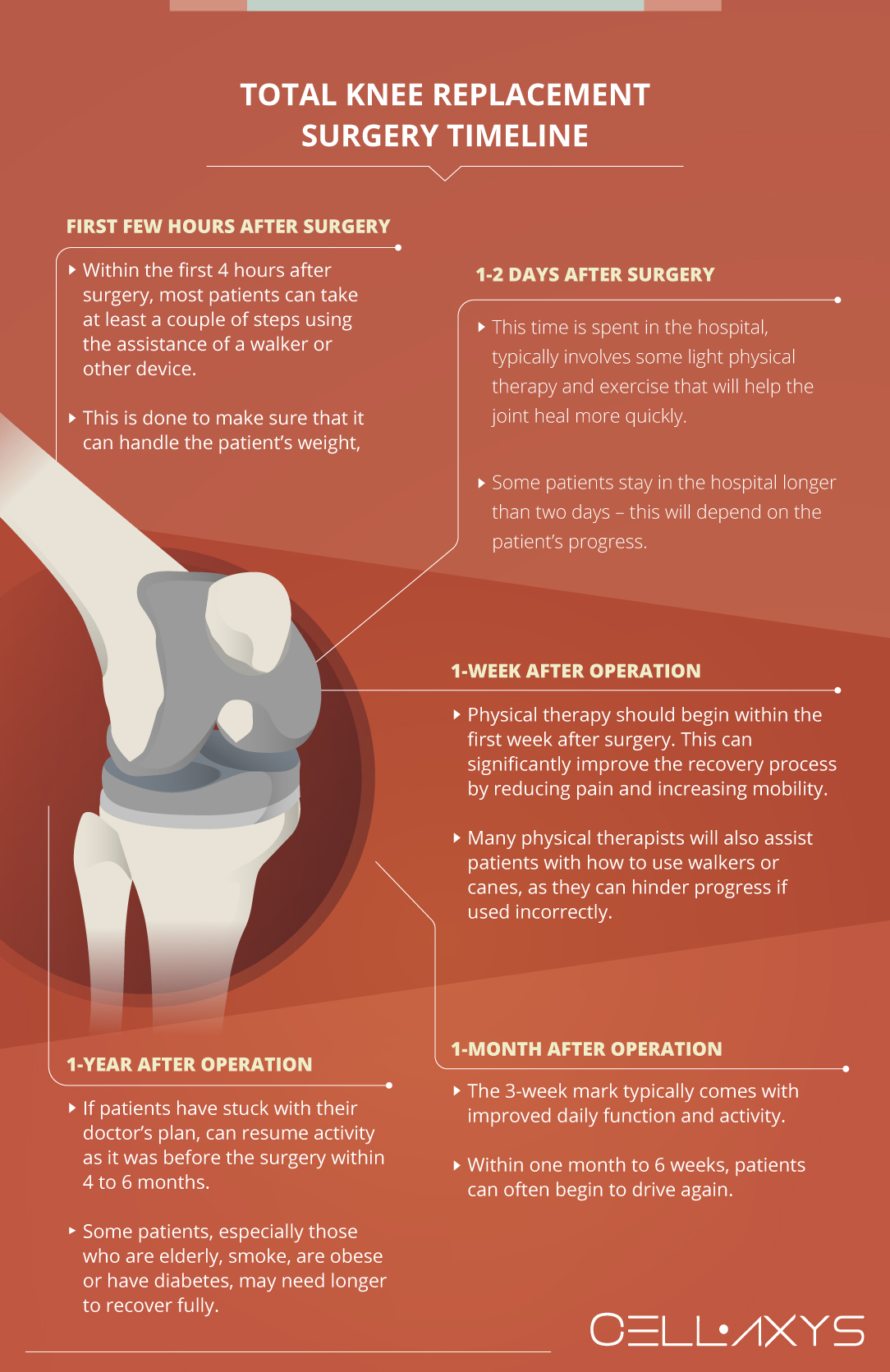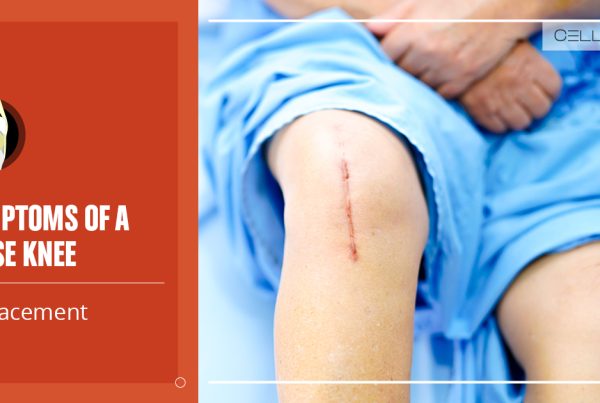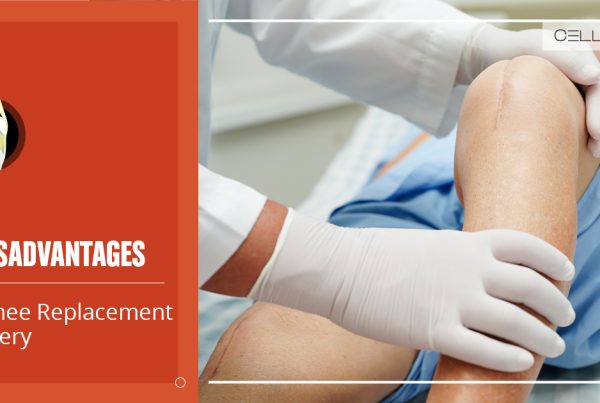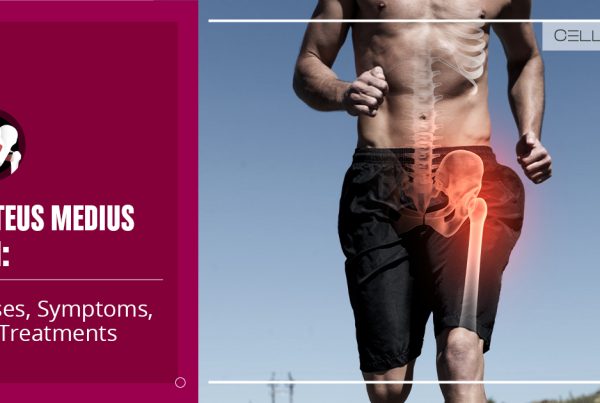Published on: December 4, 2019 | Updated on: November 4, 2024
Knee pain can be debilitating and significantly impact daily life. Simple tasks such as driving or walking around can become unbearable. Once it becomes too much to bear, many individuals will seek a doctor’s advice on how to treat the pain best. Doctors can determine the source of pain through different diagnostic tests and devise a plan to solve it.
Often, knee replacement surgery is the last resort, pursued only when all else has failed. Although it is considered a major surgery, due to technological advancements and surgical techniques, knee replacement recovery time is relatively short. Many symptoms that patients experience during recovery can be managed to provide maximum comfort while healing.
Anatomy of the Knee
Three bones form the knee joint; the patella (kneecap), tibia (shin), and femur (thigh) are the main bones that articulate joint movement, with the fibula adjacent to the tibia and connected by an important structure called a ligament. There is articular cartilage between the three prominent bones – the purpose of this soft tissue is to act as a cushion between the bones. If the bones begin to rub against one another, they can cause pain and discomfort.
There is also a type of cartilage called the meniscus that is slightly tougher than articular cartilage. The meniscus acts to absorb shock between the femur and tibia.
Ligaments are rugged bands of tissue that connect two bones or cartilage for joint movement. There are four large ligaments in the knee, such as the ACL (anterior cruciate ligament) and PCL (posterior cruciate ligament), which provide support and mobility to the joint. These ligaments can become torn or damaged during activity and cause pain, swelling, and an inability to walk. The other large ligaments are the LCL (lateral collateral ligament) and the MCL (medial collateral ligament).
Due to the complex nature of the knee joint, many minor injuries could potentially lead to knee replacement surgery if left untreated.
Diagnosing a Knee Injury
Knee pain can be a burden, but once it starts to impact daily activities, it might be time to see a doctor. Informing them of medical history, symptoms, previous injury, and length of time since the pain began can help doctors diagnose. It is important to answer their questions honestly so that they can make the correct diagnosis.
Diagnosing knee pain typically begins with a non-invasive diagnostic test that will determine relevant factors, such as the pain’s range of motion and location. This includes watching the knee bend and straighten in different positions.
They may watch a patient walk to observe if there is a limp. Some doctors can make a diagnosis based on these tests alone, but many will order slightly more invasive diagnostic techniques so that they can be certain. These diagnostic methods include:
- MRI: Magnetic Resonance Imaging allows doctors to examine the soft tissue in a patient’s body, which may indicate damaged cartilage, tendons, or muscles.
- X-ray: This imaging technique examines bones. It may be employed if a patient’s knee pain is caused by an abnormality in the bones’ alignment or if there are bone spurs around the joint.
- CT scan: This imaging technique shows a 3D image of a cross-section. It can allow doctors to diagnose certain conditions, but it is often not used as a diagnostic method because MRI and X-rays are often enough to inform a diagnosis.
Surgery is often unnecessary if knee pain is addressed in its early stages. Conventional treatments are often enough to fix the issue and stop the progression of an injury.
Conventional Treatments for Knee Pain
There are many potential causes of knee pain, each with its own treatment process. Doctors can also tailor a patient’s recovery to meet their specific needs. Although recovery details vary, the general process is often the same.
The knee replacement recovery time, in order, generally follows this path:
- RICE Method: Rest, ice, compression, and elevation. Employing these techniques may be enough to get an injury to begin healing. These are often coupled with NSAIDs (Non-Steroidal Anti-Inflammatory Drugs) for pain relief.
- Wearing a Brace: Some doctors may recommend that a brace be worn. Sometimes, it is only recommended to wear during activities that cause pain, or it may be prescribed for full-time use. It may also be recommended that a patient use a cane or a walker to alleviate the pressure on the joint. How often these devices should be used is individual to each patient. Doctors or physical therapists will recommend how these devices should be used.
- Physical Therapy: One of the most successful forms of treatment is physical therapy. Professionals can guide patients through the recovery process using different exercises. These exercises can often be done at home and in a therapist’s meeting. The main goals of physical therapy are to improve the range of motion and strengthen the muscles surrounding an injury so that the joint has more support while it heals. If physical therapy is started at the beginning stages of an injury, it has a vast potential to stop further progression of the injury.
- Corticosteroid Injections: These are used as pain relievers for many knee injuries. The cortisone delivers a powerful anti-inflammatory injection into the injury, which can significantly reduce pain. However, these shots pose the risk of damaging soft tissue over time and should be monitored closely.
- Surgery: Total knee replacement surgery is at the end of the surgical spectrum for a knee injury. A patient may need many other minor surgeries to repair the knee joint. Many of these surgeries are done together in one operation. Minor knee surgeries can include:
- Arthroscopy: This form of surgery uses a tiny camera to go into the joint and see what damage has occurred and where. This can be used as a diagnostic method but is most often used for surgery. While the tiny camera is there, doctors can use other small tools to accomplish many things. Some injuries that can be fixed during arthroscopy include removing bone spurs, repairing a torn meniscus, and repairing damaged ligaments.
- Partial Knee Replacement: This surgery replaces one or two parts of the joint rather than three of the main bone ends. It requires a smaller incision than a total knee replacement, and the recovery time is often a bit shorter as there are fewer adjustments for the body to make.
Each treatment method will be experienced differently by each patient. Committing to the recovery process means doing physical therapy as recommended, using assistive devices as recommended, and sticking to the plan. Deviation from the treatment plan isn’t fatal, but it can cause greater pain and discomfort later on and significantly delay healing time.
Making the Decision
Almost all total knee replacement surgeries are elective, meaning that the patient can decide whether or not they may go through with it. Many factors may influence this decision, including money, overall health, support system, and work or home life.
Doctors and surgeons are here to help their patients as much as they can. Having an open discussion about what to expect before, during, and after surgery can be extremely beneficial to a patient. Having clear expectations of what will happen in the future can ease a lot of stress and anxiety surrounding the decision.
When Can You Make a Full Recovery?

Each patient’s recovery timeline will be a little different from the next. This surgery timeline is based on a typical recovery process and may not reflect yours exactly.
This guideline is meant to help patients prepare for total knee replacement with the most common outcomes. Remember to discuss with doctors and surgeons when questions arise. The typical timeline is as follows:
Preparing for the Knee Replacement Surgery
Before heading into the operating room, patients must take steps to ensure safety. These include scheduling blood work, arranging a ride from the hospital, bringing a clean change of clothes, and taking time off work.
Doctors will inform patients if they must refrain from eating or drinking for a certain period before surgery. Getting plenty of sleep on the days leading up to surgery is important to ensure you are as healthy as possible going into the operation.
Learning about anesthesia is also useful during the preparation process. Find out if your doctor plans to use a general, regional, or localized anesthetic. The biggest risks of anesthesia are stroke, blood clots, and pneumonia.
The Procedure
Total knee replacement surgery involves inserting a prosthesis into the end of each knee bone to ensure fluid movement. Doctors begin by changing the shape of the bone to better fit the prosthesis, which often cuts off any damaged parts of the bone.
The prosthesis is placed on the bone and held in place using bone cement. Before closing the surgical incision, surgeons will test the knee’s bending ability. This determines if the attachment has been placed correctly. In this stage, if the prosthesis is loose or misaligned, it can be quickly fixed, though this is unlikely.
First Few Hours After Surgery
Most patients will be encouraged to stand up within the first couple of hours after the surgery. Doing so will help test the new knee to ensure it can handle the patient’s weight and indicate their comfort level.
Within the first 4 hours after surgery, most patients can take at least a couple of steps using the assistance of a walker or other device.
Immediate Post-Surgery Phase
The first week, or the day after the surgery to day 7, falls under the immediate post-surgery phase. During the first three days, the patient is usually kept in the hospital under proper care, and the remaining four days are spent resting at home.
During your hospital stay, the medical department will monitor your health for post-surgery complications like infections, formation of blood clots, or excessive bleeding.
Pain will be managed with medications, and often, the very next day after the surgery, you will be encouraged to start moving and walking. This is crucial to minimize the risk of blood clot formation and internal healing. Physical therapy will also begin, where gentle exercises will help you move your leg and encourage you to use a walker or crutches.
Pain relief medication like NSAIDs and opioids will be continued, and ice therapy and leg elevation techniques will also help reduce any swelling and discomfort.
Early Recovery Phase
The first month after the first week will be spent at home for recovery. You must continue physical therapy to improve mobility and joint strength. Assistive aids like walkers and canes may be required to help your body adapt to the surgery.
Moreover, incision care is critical to avoid infection. The wound must be kept clean and dry per the doctor’s instruction, and the dressing and activity restrictions must be followed as advised.
You must inform your doctor of any redness, discharge, or discomfort around the incision site. Slowly, the pain will become manageable, and you can rely less on the pain medication for relief.
Mid-Recovery Phase
The following month will be much better than the first, and you will notice a significant improvement in your leg movement. You will be able to reduce reliance or let go entirely of the cane and walker, and you will feel your knee getting more robust and stable.
Physical therapy will be continued, but it will be more aggressive at this point. Exercises will focus on improving and strengthening the muscles around the knee, hamstrings, and quadriceps.
This will ensure you return to your routine life as soon as possible. You can now engage in low-impact activities like swimming, cycling, and walking.
Full Recovery Phase
About 2 to 4 months after the surgery, you will be able to walk without any support and will also be able to perform all of your daily activities without any pain or discomfort. Still, it is recommended that you continue physical therapy to gain complete strength and flexibility after you reach the 4-6-week mark.
You may return to your job as long as it is a desk job, but it is better to wait 3 to 6 months until your knee is strong enough for physically demanding jobs.
1 Year After Operation
If stuck with their doctor’s plan, most patients can resume activity before the surgery within 4 to 6 months. Some patients, especially those who are elderly, smoke, are obese, or have diabetes, may need longer to recover fully.
This process can seem overwhelming. Keep in mind that knee replacement surgeries are common and have a very high success rate. Compared to other surgeries, the recovery time is also relatively short. However, regenerative medicine may be able to make the recovery process even shorter.
The Role of Regenerative Medicine in Total Knee Replacement
The new field of regenerative medicine seeks to use a patient’s own cells to enhance the healing process, regenerate the tissue in the knee, or preserve the functional cartilage. CELLAXYS offers two types of regenerative therapy: Cell-based therapies are focused on maintaining the native cartilage and improving pain and function.
In some cases, knee replacement surgeries can be postponed or avoided with these procedures.
Cell-Based Therapies
The Stem Cell Procedure begins with harvesting a patient’s adipose or bone marrow tissue. The cells are then processed to be more concentrated and transplanted into the knee or surgery site. Stem cells contain healing properties that the body already uses when an injury or damage occurs. Placing concentrated healing cells into a part of the body that is healing can help the damage heal faster.
Platelet-rich plasma Therapy begins with a simple blood draw. The patient’s blood is then placed in a centrifuge to separate platelets in the blood from other components. The platelets are then injected into the injury or surgery site, similarly to stem cell therapy.
Platelets contain proteins and growth factors that the body uses naturally to heal damage. Increasing the amount of these properties where damage has occurred could help the injury heal faster with PRP.
Each type of regenerative therapy is low-risk, as it uses the patient’s own cells. Some experience a slight pain at the injection site, but this typically goes away in a matter of days. Regenerative medicine can be a great option during the recovery process of knee replacement surgery. These treatments could provide the boost you need to complete recovery tasks more efficiently.
It should also be noted that some patients who have undergone these treatments have been able to surpass the need for surgery. In some cases, regenerative medicine can heal an injury to the point where surgery is no longer necessary. When this is the case, the recovery process is drastically simplified. The healing process for regenerative therapy is short, typically 3-5 days for most cases. Patients are generally recommended to continue physical therapy, as it can help in ways that regenerative medicine cannot.
Sources
Footnotes
- Davis AM, Perruccio AV, Ibrahim S, Hogg-Johnson S, Wong R, Streiner DL, Beaton DE, Cote P, Gignac MA, Flannery J, Schemitsch E. The trajectory of recovery and the inter-relationships of symptoms, activity and participation in the first year following total hip and knee replacement. Osteoarthritis and Cartilage. 2011;19(12):1413-21.
- Ibrahim MS, Alazzawi S, Nizam I, Haddad FS. An evidence-based review of enhanced recovery interventions in knee replacement surgery. The Annals of The Royal College of Surgeons of England. 2013;95(6):386-9.
- Venkataramanan V, Gignac MA, Mahomed NN, Davis AM. Expectations of recovery from revision knee replacement. Arthritis Care & Research: Official Journal of the American College of Rheumatology. 2006;55(2):314-21.
- Isaac D, Falode T, Liu P, I’Anson H, Dillow K, Gill P. Accelerated rehabilitation after total knee replacement. The knee. 2005;12(5):346-50.
- Shakespeare D, Kinzel V. Rehabilitation after total knee replacement: time to go home?. The Knee. 2005;12(3):185-9.
References
- Total Knee Replacement Surgery Recovery. Arthritis-Health. Accessed 2/23/2024.
- Recovering from a knee replacement. NHS. Accessed 2/23/2024.
- Knee Replacement. Cleveland Clinic. Accessed 2/23/2024.
- 6 Things to Know About Recovery After Knee Replacement. HSS. Accessed 2/23/2024.
CELLAXYS does not offer Stem Cell Therapy as a cure for any medical condition. No statements or treatments presented by Cellaxys have been evaluated or approved by the Food and Drug Administration (FDA). This site contains no medical advice. All statements and opinions are provided for educational and informational purposes only.
Dr Pouya Mohajer
Author
Pouya Mohajer, M.D. is the Director of Spine and Interventional Medicine for CELLAXYS: Age, Regenerative, and Interventional Medicine Centers. He has over 20 years of experience in pain management, perioperative medicine, and anesthesiology. Dr. Mohajer founded and is the Medical Director of Southern Nevada Pain Specialists and PRIMMED Clinics. He has dedicated his career to surgical innovation and scientific advancement. More about the doctor on this page.
Dr Pejman Bady
Contributor
Dr. Pejman Bady began his career over 20 years ago in Family/Emergency Medicine, working in fast-paced emergency departments in Nevada and Kansas. He has served the people of Las Vegas as a physician for over two decades. Throughout this time, he has been met with much acclaim and is now the head of Emergency Medical Services in Nye County, Nevada. More about the doctor on this page.









